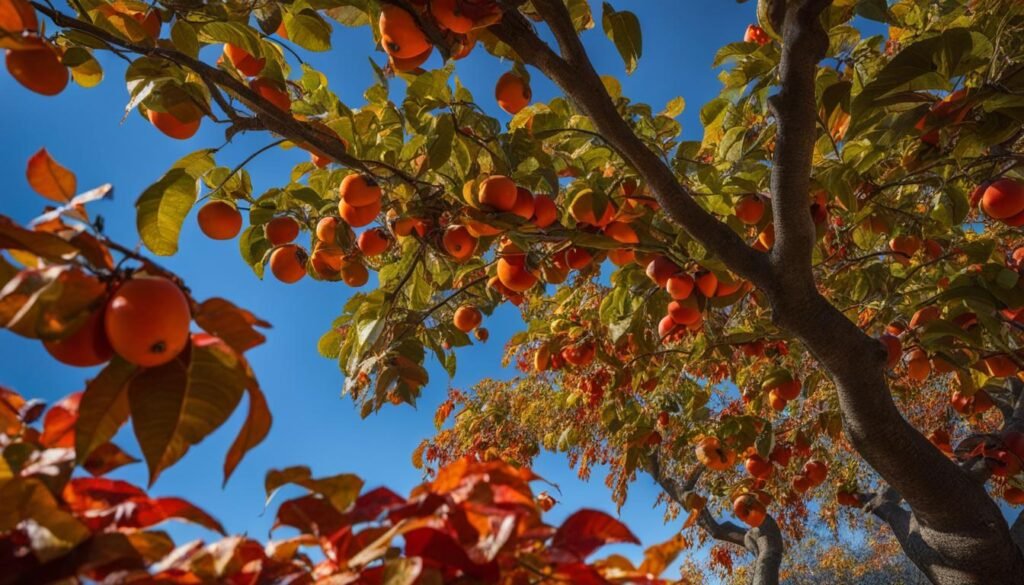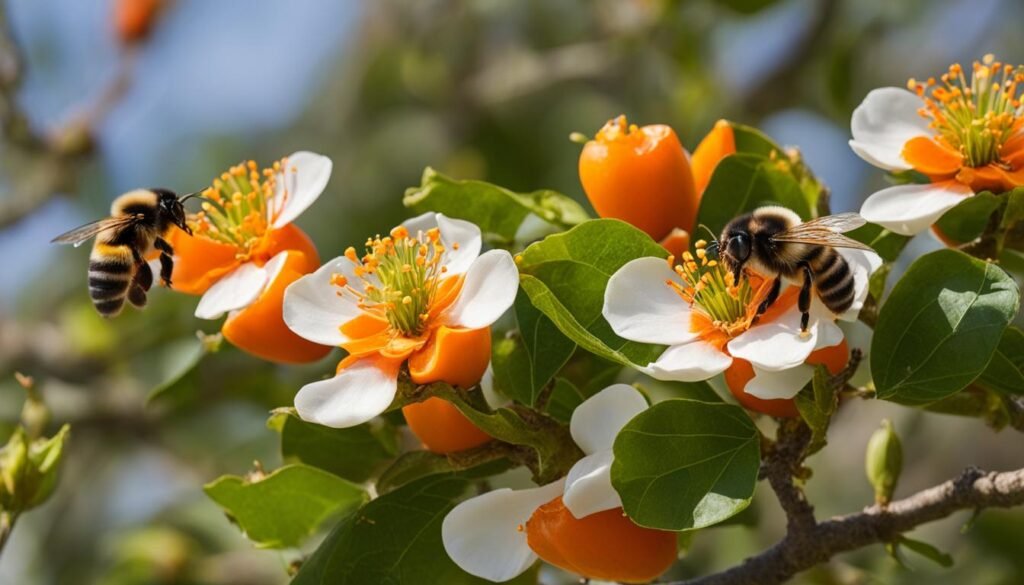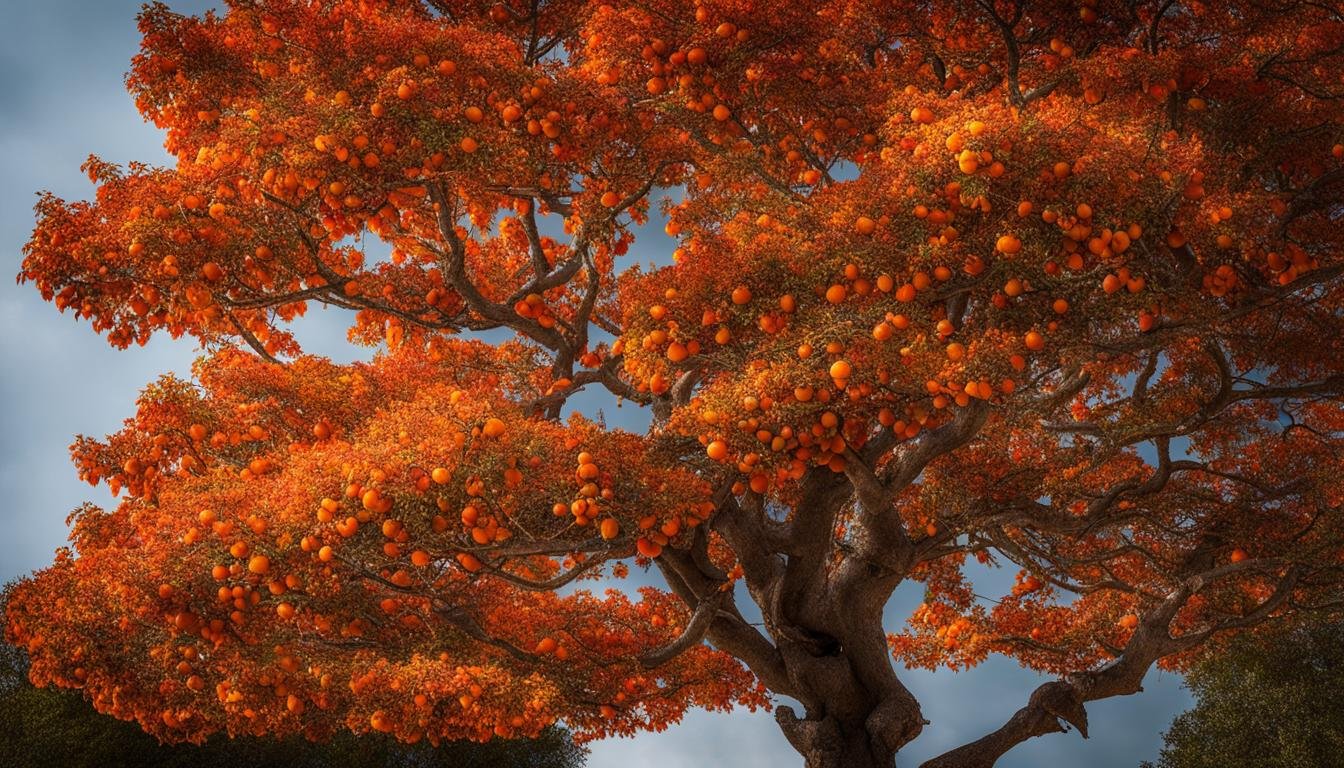As autumn approaches, nature transforms into a canvas of vibrant colors, and one tree that steals the spotlight is the persimmon tree. With its stunning display of fall foliage, the persimmon tree adds a touch of magic to any landscape. The leaves transition from their usual blue-green hue to a breathtaking spectrum of yellow, orange, and red, creating a visual masterpiece that captivates the eye.
But it’s not just the leaves that contribute to the seasonal beauty of the persimmon tree. The tree’s fruit itself, from pale orange to deep red, adds a pop of color to the fall landscape, making it truly mesmerizing.
When autumn arrives, the persimmon tree transforms into a symbol of nature’s artistic prowess. Its colorful foliage and vibrant fruits evoke a sense of joy and wonder as we witness the changing seasons unfold.
Key Takeaways:
- The persimmon tree showcases a stunning display of fall foliage, with beautiful shades of yellow, orange, and red.
- The persimmon fruit adds an additional burst of color, ranging from pale orange to deep red.
- Witnessing the persimmon tree in autumn is a breathtaking experience that adds seasonal beauty to any landscape.
- The changing colors of the persimmon tree leaves create a visual masterpiece, showcasing nature’s artistic prowess.
- Appreciating the beauty of the persimmon tree in fall foliage is a delightful way to embrace the changing seasons.
Types of Persimmon Trees
When it comes to persimmon trees, there are several varieties that are worth exploring. Each type has its own unique characteristics and offers something special to gardeners and landscape enthusiasts. Let’s take a closer look at the different types of persimmon trees:
American Persimmon
The American persimmon (Diospyros virginiana) is a native tree to the United States. It can reach heights of up to 60 feet and has oblong, bluish-green leaves that turn beautiful shades of yellow, orange, and red in the fall. The American persimmon is known for its adaptability to various climates and its ability to withstand harsh winter conditions.
Japanese Persimmon
The Japanese persimmon (Diospyros kaki) is a widely cultivated variety known for its sweet and delicious fruits. These persimmon trees can grow to heights of 4.5 to 18 meters and are cherished for their ornamental value as well. The leaves of the Japanese persimmon also exhibit stunning fall colors, adding to the overall beauty of the tree.
Chinese Persimmon
Another popular variety is the Chinese persimmon, which is known for its adaptability and ability to thrive in different climates. Chinese persimmon trees produce delicious fruits and have become a favorite among growers. While they may not be as well-known as their Japanese counterparts, Chinese persimmon trees offer their own set of unique qualities.
Each type of persimmon tree brings its own charm and beauty to the landscape. Whether you’re looking for stunning fall foliage, delicious fruits, or a combination of both, there is a persimmon tree variety that will suit your needs.

Table: Comparison of Persimmon Tree Varieties
| Variety | Height | Leaf Color | Fruit Characteristics |
|---|---|---|---|
| American Persimmon | Up to 60 feet | Blue-green to vibrant shades of yellow, orange, and red | Small, astringent fruits |
| Japanese Persimmon | 4.5 to 18 meters | Green to vibrant shades of yellow, orange, and red | Large, sweet, non-astringent fruits |
| Chinese Persimmon | Varies | Green to vibrant shades of yellow, orange, and red | Medium-sized, sweet fruits |
This table provides a brief comparison of the different persimmon tree varieties, highlighting their height, leaf color, and fruit characteristics. It’s important to note that these characteristics may vary depending on specific cultivars within each variety. When selecting a persimmon tree for your landscape, consider your climate, desired fruit flavor, and aesthetic preferences to find the perfect fit.
Characteristics and Appearance of Persimmon Trees
Persimmon trees are known for their unique characteristics and striking appearance. Let’s delve into the details about their size, growth, leaves, bark, flowers, and fruits.
Persimmon Tree Size and Growth:
Persimmon trees can vary in size depending on the variety. American persimmons can reach heights of up to 10 meters, while Japanese persimmons grow to heights ranging from 4.5 to 18 meters. These trees have a moderate growth rate and can live for several decades, providing beauty and shade to any landscape.
Persimmon Tree Leaves and Bark:
The leaves of persimmon trees are noteworthy for their dark green, glossy appearance. They are leathery and oval-shaped, measuring around 2 to 3 inches in length. In the fall, these leaves undergo a stunning transformation, turning vibrant shades of yellow, orange, and red. The bark of persimmon trees is typically gray to brown in color and can have a distinctive ridged pattern, adding visual interest to the tree’s overall appearance.
Persimmon Tree Flowers and Fruits:
Persimmon trees produce small, inconspicuous flowers that are typically white or yellowish in color. These flowers bloom in the spring and are pollinated by wind or bees. Once pollinated, the trees bear fruit, which is a defining feature of persimmon trees. Persimmon fruits can range in color from dark red to maroon and have a flat, round shape. They are known for their sweet, juicy flavor and are often enjoyed fresh or used in various culinary creations.

| Persimmon Tree Propagation Methods | Persimmon Tree Pollination Requirements |
|---|---|
| Root Cuttings | Some varieties are self-pollinating |
| Seed Germination | Many varieties require cross-pollination |
Cultivation and Uses of Persimmon Trees
Persimmon trees are not only beautiful but also highly versatile, offering a variety of uses beyond their aesthetic appeal. Let’s explore the cultivation and the different ways in which persimmon trees can be utilized.
Growing Persimmon Trees
Persimmon tree cultivation is relatively straightforward, making it accessible to both experienced gardeners and beginners. These trees thrive in well-drained soil and require ample sunlight for optimal growth. Regular watering and balanced fertilization are essential for maintaining healthy trees.
It is important to note that persimmon trees typically take a few years to become established and start producing fruit. Patience and proper care are key to ensure a bountiful harvest in the future.
Persimmon Tree Fruits
The most well-known use of persimmon trees is undoubtedly their delicious fruits. Ripe persimmons can be eaten fresh or used in various culinary preparations, such as pies, jams, and salads. The unique flavor profile of persimmon fruit, which is often described as sweet and slightly tangy, adds a delightful twist to both sweet and savory dishes.
Persimmon Tree Hoshigaki
A traditional Japanese delicacy, hoshigaki is dried persimmon fruit that undergoes a meticulous process of air drying and hand massaging. This technique intensifies the sweetness of the fruit while creating a chewy texture. Hoshigaki is a popular treat during the winter season and is highly regarded for its exquisite taste and unique cultural significance.
Persimmon Tree Wood and Leaves
The wood of the persimmon tree is prized for its hardness and durability. It is commonly used in construction, furniture making, and decorative items. The striking grain pattern and warm color of persimmon wood make it a sought-after material for artisanal products.
Persimmon tree leaves, on the other hand, have found their place in traditional Japanese ceremonies and teas. They are also known for their healing properties and are used in herbal remedies.
| Uses of Persimmon Trees | Examples |
|---|---|
| Culinary | Pies, jams, salads |
| Traditional Japanese | Hoshigaki (dried fruit) |
| Woodworking | Construction, furniture, decorative items |
| Traditional Ceremonies | Tea ceremonies, herbal remedies |

Climate Considerations for Growing Persimmon Trees
Growing persimmon trees requires careful consideration of the climate conditions. Persimmon trees thrive best in areas with moderate winters and relatively mild summers. They are well-suited for USDA hardiness zones 7 to 10, where temperatures rarely drop below 0 degrees Fahrenheit when dormant. However, it is important to note that temperatures below 26 degrees Fahrenheit when the tree is actively growing can cause damage to the leaves.
The ability of persimmon trees to tolerate cold temperatures varies depending on the cultivar. Some varieties, such as ‘Hachiya’ and ‘Fuyu’, have shown greater cold hardiness compared to others. It is advisable to choose a cultivar that is more suited to the specific climate of your area.
Microclimates also play a role in the successful cultivation of persimmon trees. Factors such as proximity to large bodies of water, elevation, and the presence of windbreaks can create microclimates that are more favorable for persimmon tree growth. It is important to understand the unique climatic conditions of your specific location before planting persimmon trees.
| Climatic Factor | Persimmon Tree Requirement |
|---|---|
| Sunlight | Full sun exposure |
| Soil | Well-drained soil |
| Temperature | Hardy in USDA zones 7 to 10; dormant trees can tolerate temperatures as low as 0 degrees Fahrenheit |
| Watering | Adequate watering as needed |
| Microclimates | Consider proximity to bodies of water, elevation, and windbreaks |
In summary, persimmon trees require a climate with moderate winters and mild summers to thrive. Understanding the hardiness zones and temperature tolerance of persimmon trees is crucial for successful cultivation. Additionally, considering microclimates can provide a more favorable environment for persimmon tree growth. By selecting the right cultivar and ensuring adequate sunlight, well-drained soil, and proper watering, you can enjoy the beauty and harvest of persimmon trees.
Cultivars of Persimmon Trees
When it comes to persimmon trees, there are several cultivars that stand out for their unique characteristics and delicious fruits. These cultivars have been carefully developed over the years to offer a range of flavors, textures, and overall growing experiences. Whether you’re looking for a sweet and juicy variety or a more astringent option, there’s a persimmon tree cultivar to suit your tastes.
The ‘Hachiya’ cultivar
The ‘Hachiya’ cultivar is known for its distinctive teardrop-shaped fruits. This astringent variety of persimmon is typically harvested when fully ripe to ensure its sweet and flavorful taste. The fruits have a vibrant orange color and a soft, custard-like texture that is perfect for eating fresh or incorporating into various recipes, such as persimmon pudding and baked goods.
The ‘Fuyu’ cultivar
If you prefer a non-astringent variety, the ‘Fuyu’ cultivar is an excellent choice. The fruits of the ‘Fuyu’ variety are round and flattened, similar to a tomato. They have a bright orange color and a firm texture, making them ideal for eating fresh or slicing into salads. Unlike astringent persimmons, ‘Fuyu’ fruits can be enjoyed even when they are still firm and have a crisp, apple-like flavor.
The ‘Saijo’ cultivar
For those who prioritize consistent fruiting and cold hardiness, the ‘Saijo’ cultivar is a top pick. This variety of persimmon tree is known for its reliable production of high-quality fruits. ‘Saijo’ persimmons have a reddish-brown skin and a sweet, honey-like flavor. They are often enjoyed fresh or used in jams and preserves.
| Cultivar | Fruit Characteristics |
|---|---|
| ‘Hachiya’ | Teardrop-shaped, astringent, soft texture |
| ‘Fuyu’ | Round and flattened, non-astringent, firm texture |
| ‘Saijo’ | Reddish-brown skin, non-astringent, sweet flavor |
These are just a few examples of the many persimmon tree cultivars available. Each variety has its own unique characteristics, making the world of persimmons a delightful and diverse one to explore. From the astringent ‘Hachiya’ to the sweet and firm ‘Fuyu’ and the reliable ‘Saijo’, there’s a persimmon tree cultivar to suit every palate and growing situation. Planting different cultivars can also enhance cross-pollination and increase fruit production, creating a bountiful persimmon harvest.
Persimmon Trees in Japanese Culture
Persimmon trees have a rich cultural significance in Japan and are deeply rooted in the country’s traditions. They hold a special place in Japanese culture and have been celebrated in various artistic expressions, including poetry, paintings, and ceramics. The symbolism of persimmon trees is closely tied to their seasonal beauty and the unique characteristics of their fruits.
In Japanese culture, persimmon trees are often associated with autumn, representing the changing of seasons and the transient nature of life. The vibrant colors of the persimmon tree’s fall foliage are celebrated as a symbol of beauty and impermanence. Artists and poets have long been inspired by the sight of persimmon trees in their full autumn glory, capturing their essence in haiku poems and intricately painted landscapes.
The fruits of the persimmon tree also hold cultural significance in Japan. They are used in traditional Japanese sweets and decorations, symbolizing good luck, abundance, and longevity. Persimmon fruits are an important part of New Year’s celebrations, representing wishes for a fruitful and prosperous year ahead. They are also often featured in traditional tea ceremonies, adding a touch of natural beauty to the elegance of the ritual.
“The persimmon tree
In its autumn splendor
An artist’s delight”
– Matsuo Basho
Overall, persimmon trees play a significant role in Japanese culture, embodying the beauty of nature and the fleeting nature of life. Their symbolism, traditional uses, and cultural significance have been passed down through generations, making persimmon trees an integral part of Japan’s cultural heritage.

Conclusion
After exploring the beauty, characteristics, cultivation, and cultural significance of persimmon trees, it is clear that these trees offer a unique and enchanting addition to any landscape. Their stunning fall foliage, with vibrant shades of yellow, orange, and red, creates a breathtaking scene that adds seasonal beauty to the surroundings.
Not only do persimmon trees provide a visual feast, but they also offer delicious fruits that can be enjoyed in a variety of ways. Whether eaten raw, used in desserts and dishes, or dried into hoshigaki, the persimmon fruit showcases its versatility and delectable flavors.
With their adaptability to different climates and ease of cultivation, persimmon trees are a popular choice for gardeners. They can thrive in various soil conditions, require ample sunlight, and benefit from adequate watering and fertilization. From planting and pruning to harvesting and enjoying the fruits, taking care of persimmon trees can be a rewarding and enjoyable experience.
Embrace the Beauty of Persimmon Trees
Overall, persimmon trees are remarkable and deserve to be appreciated for their beauty, flavor, and cultural significance. Whether you’re looking to enhance your landscape with vibrant fall foliage or savor the delicious fruits they bear, these trees can bring joy and a touch of seasonal magic to your surroundings.
So why not plant a persimmon tree and experience the wonder of its colorful foliage and bountiful harvest? You’ll be rewarded with a delightful addition to your garden, and perhaps even a taste of the cultural traditions and natural beauty that persimmon trees offer.
FAQ
What is the color of the leaves of a persimmon tree in the fall?
The leaves of a persimmon tree turn vibrant shades of yellow, orange, and red in the fall, creating a stunning display of autumn colors.
What types of persimmon trees are there?
There are three main types of persimmon trees: American persimmon, Japanese persimmon, and Chinese persimmon.
How tall do persimmon trees grow?
American persimmons can reach heights of up to 60 feet, while Japanese persimmons can grow from 4.5 to 18 meters.
What do persimmon trees look like?
Persimmon trees have dark green, glossy, and leathery leaves. The bark is gray to brown and can have a ridged appearance. The fruits can range from dark red to maroon and have a flat shape.
What are the planting and growing conditions for persimmon trees?
Persimmon trees require ample sunlight and well-drained soil. They can tolerate different soil conditions and prefer a pH around 6.0 to 6.5. They thrive in USDA hardiness zones 4 to 9.
How do you propagate persimmon trees?
Persimmon trees can be propagated through root cuttings or seed germination. Root cuttings involve taking cuttings from the tree’s roots, while seed germination requires stratifying the seeds in a moist environment.
Do persimmon trees need cross-pollination?
Some persimmon tree varieties are self-pollinating, while others require cross-pollination. Wind and bees play important roles in the pollination process of persimmon trees.
What are the uses of persimmon trees?
Persimmon trees are cultivated for their delicious fruits, which can be eaten raw or used in various dishes and desserts. Persimmon wood is used in construction and for making furniture and decorative items. The leaves are used in traditional Japanese ceremonies and as a tea.
What climate do persimmon trees prefer?
Persimmon trees do best in areas with moderate winters and relatively mild summers. They are suitable for USDA hardiness zones 7 to 10 and can tolerate temperatures as low as 0 degrees Fahrenheit when dormant.
What are some popular cultivars of persimmon trees?
Some popular cultivars of persimmon trees include ‘Hachiya’, ‘Fuyu’, and ‘Saijo’. Each cultivar has its own unique characteristics and is suited to different growing conditions.
What is the significance of persimmon trees in Japanese culture?
Persimmon trees hold a significant place in Japanese culture and are associated with autumn. They are used in traditional Japanese sweets and decorations, symbolizing good luck and longevity. Persimmon trees are also celebrated in haiku poems and are an important part of New Year’s celebrations.
What is the beauty of fall foliage on persimmon trees?
The fall foliage on persimmon trees is truly awe-inspiring. The leaves transform into vibrant shades of yellow, orange, and red, creating a breathtaking display of autumn colors that adds seasonal beauty to any landscape.
How do you care for persimmon trees?
Proper care for persimmon trees includes regular watering, pruning for shape and size control, and balanced fertilization. Harvesting the ripe persimmon fruits and enjoying them in various recipes is also a delightful experience. Incorporating persimmon trees into landscape design can add both beauty and functionality to outdoor spaces.




